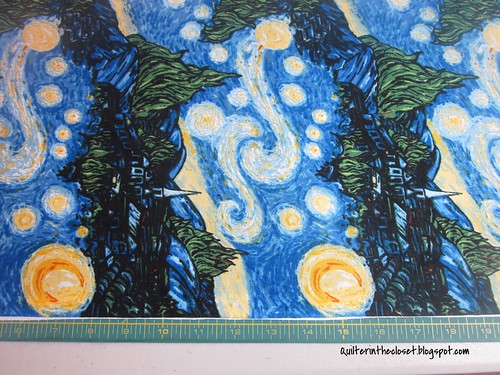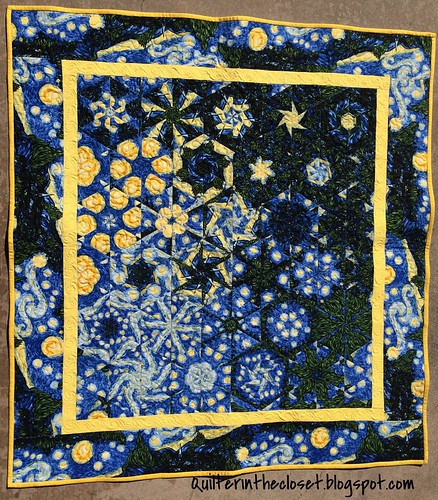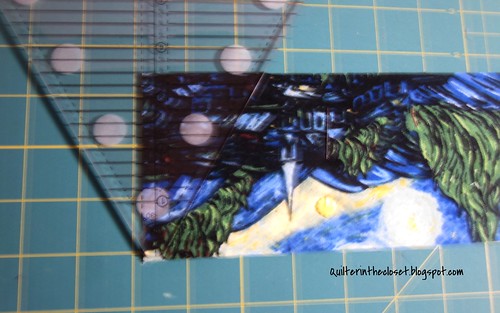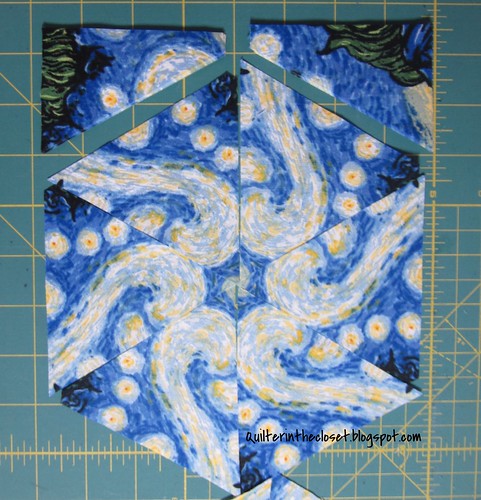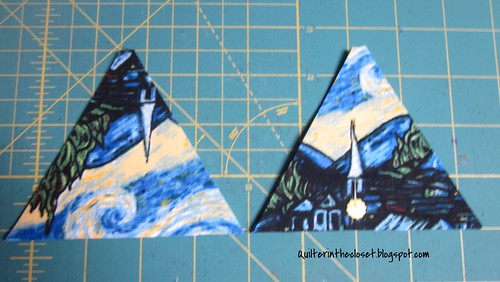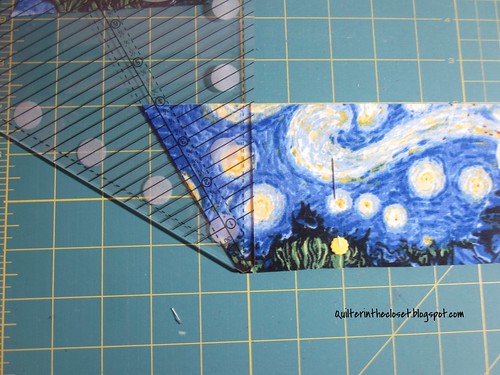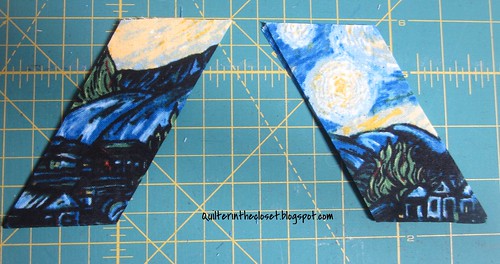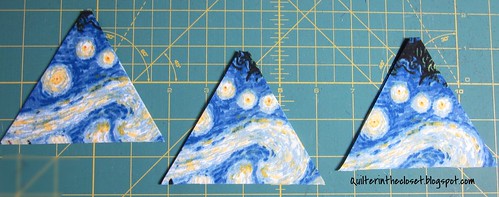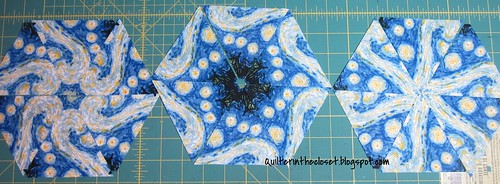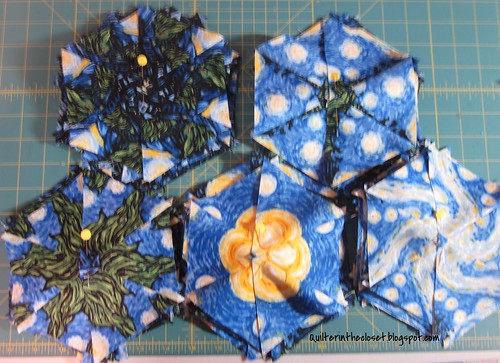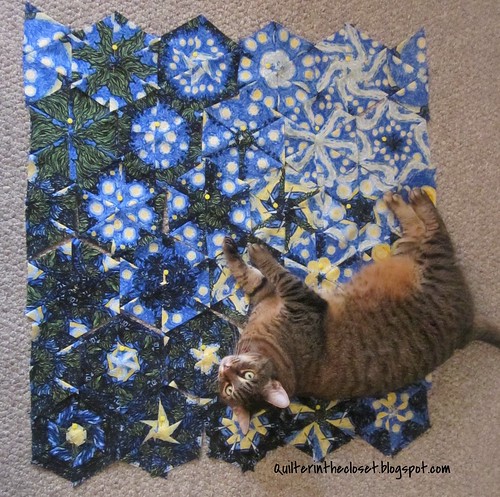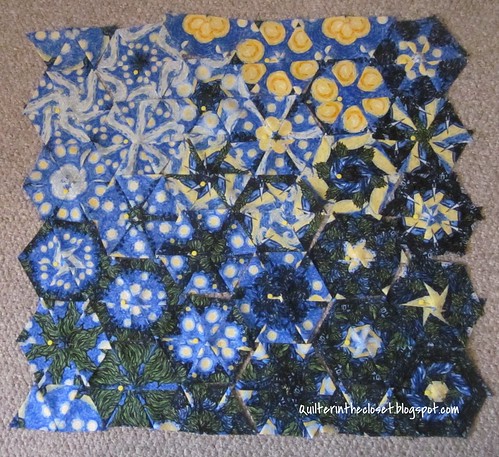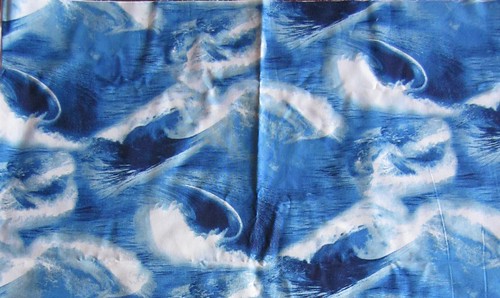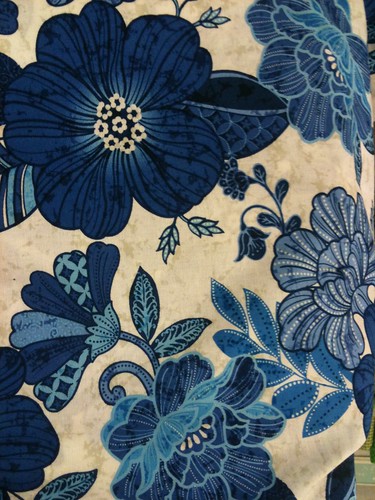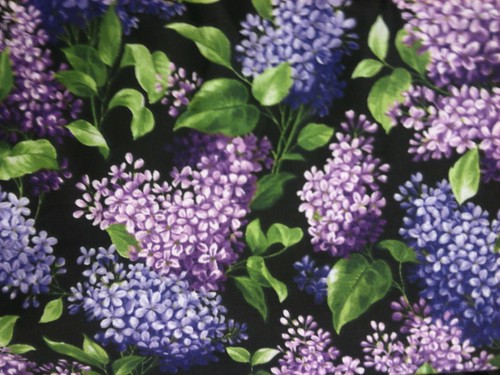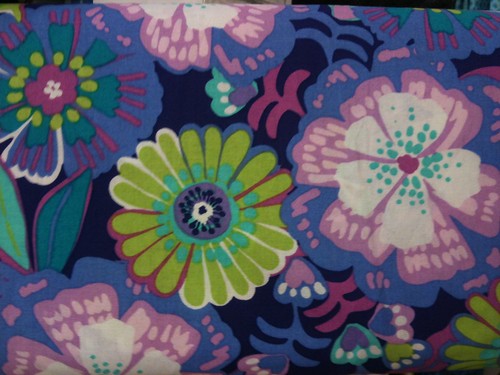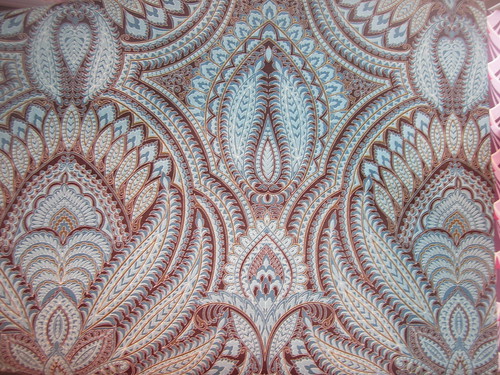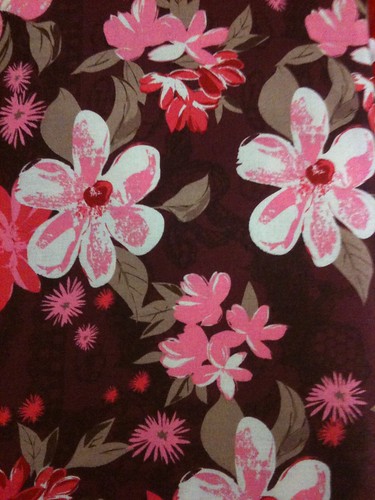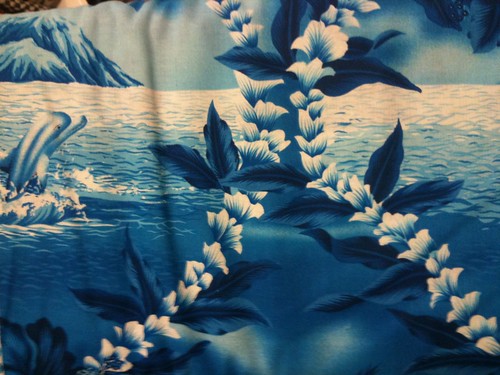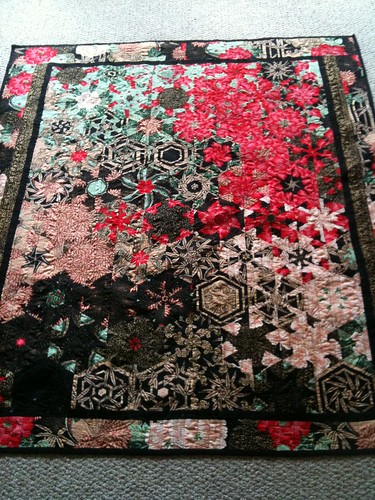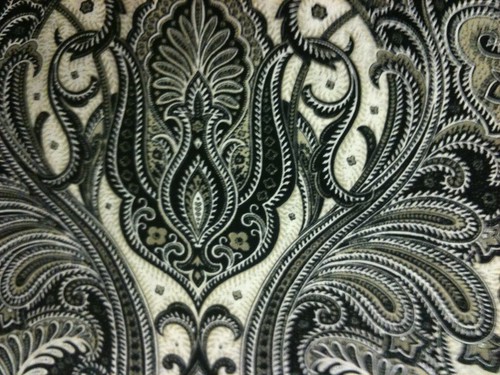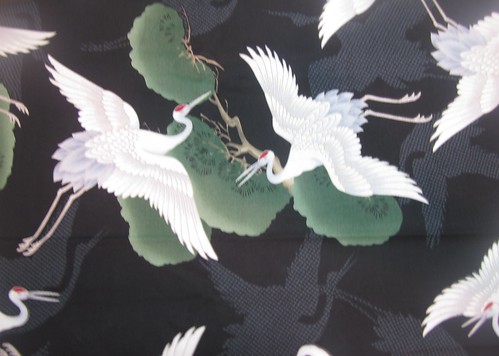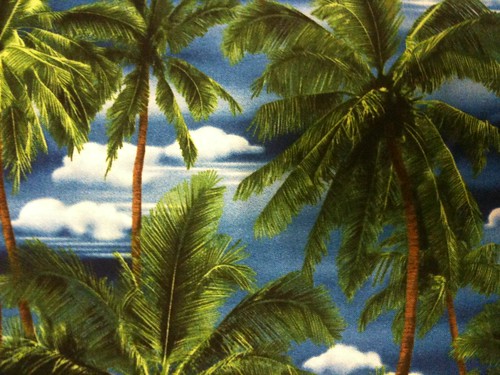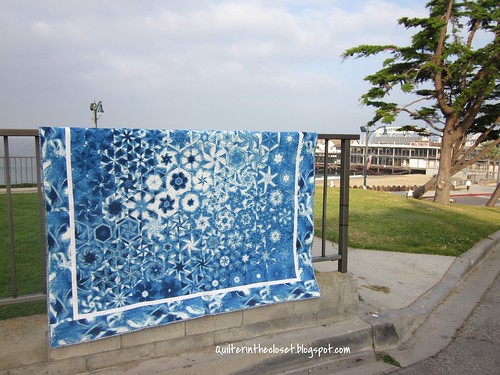Hi everyone! We have some great entries for the One Block Wonder Quilt Along!
I would like to ask your help in choosing a winner for one of the prizes. Please vote for your favorite below!
Voting will stay open until Wednesday, November 6th at 11:55pm PST, then a winner will be announced on Thursday before the end of the day!
If you are interested in seeing some other works in progress or pictures of the original fabric, please visit the Flickr group. Everyone did such a lovely job.
Thank you to everyone who participated. I think we had some fun, yes?
Jen
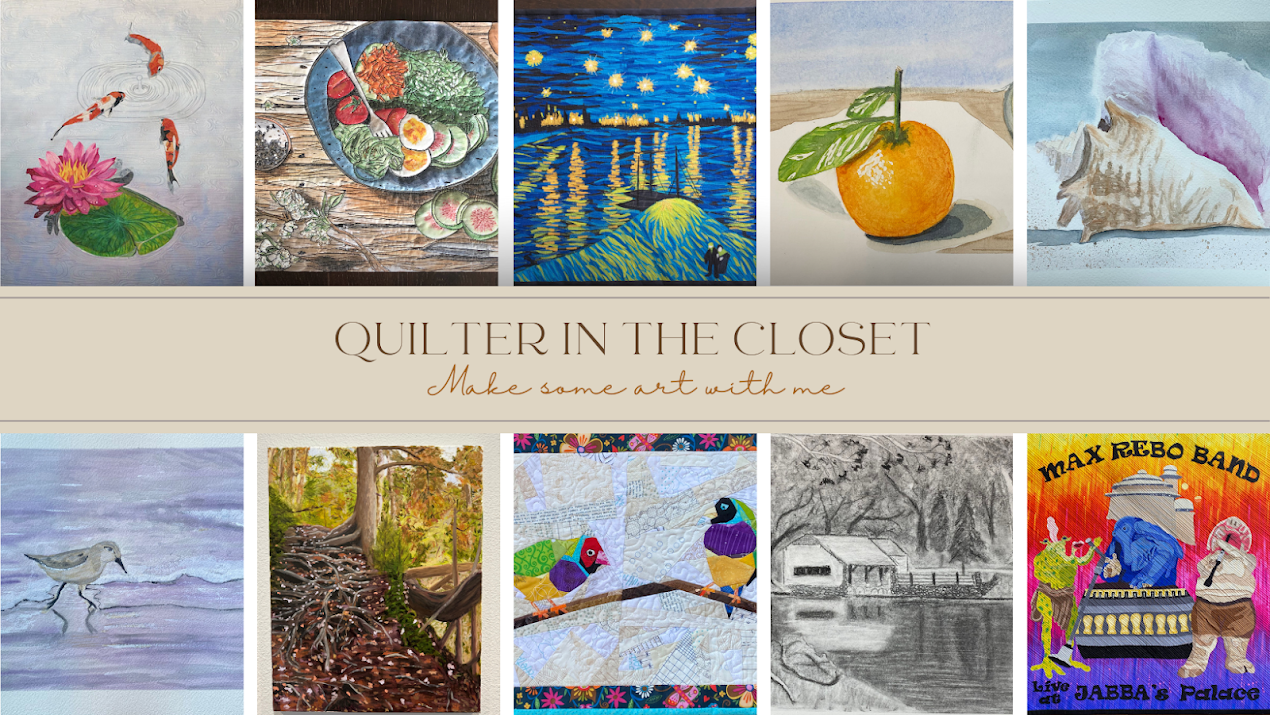
Quilter in the Closet: My artistic journey as I learn, try, and am inspired by multiple techniques, including quilting, painting, drawing, and who knows what else!
This blog may contain affiliate links to products. As an affiliate, I earn a small amount from qualifying purchases; however, it does not affect the cost of the item to you, nor am I compensated if you do not purchase.
Showing posts with label QALs. Show all posts
Showing posts with label QALs. Show all posts
Thursday, October 31, 2013
Thursday, October 17, 2013
Linky open - One Block Wonder Quilt Along
I am so happy to say that it is finally time to see everyone's quilt tops from the One Block Wonder Quilt Along! There have been some really interesting choices of fabrics and I can't wait to see how they all come together!
Here is a picture of my original fabric:
And a picture of my quilt top:
Now it is time to show off your quilts and quilt tops!
A few reminders:
Here is a picture of my original fabric:
And a picture of my quilt top:
Now it is time to show off your quilts and quilt tops!
A few reminders:
- You only need to have a completed quilt TOP to enter
- Please link up only to the page in your blog showing your completed quilt top or quilt, not just the blog homepage. Flickr pictures are also OK.
- Make sure to put your blog name as the description so people know where they are going or the name of your quilt
- If possible, include a picture of your original fabric in your post. I am sure people will be interested in the transformation (and let's not forget there is a special prize for "Most Amazing Transformation"
- Visit other linky participants!
- This link will close on October 30th at 11:55 pm Pacific Standard Time
- Come back here on Thursday, October 31st and vote for your favorite
- There are 2 $25 gift certificates to the Intrepid Thread up for grabs!
Oh, I am so anxious to see everyone's quilts!
Thank you for participating!
Jen
Thursday, October 10, 2013
Quilting tips for the One Block Wonder Quilt Along
We've got some great looking OBW quilt tops in progress in the Flickr group.. I cannot wait to see how they all turn out.
This is going to be a really short post with some quilting tips for your OBW quilts.
There are really only two things I want to emphasize:
This is going to be a really short post with some quilting tips for your OBW quilts.
There are really only two things I want to emphasize:
- Stitch in the Ditch
- Keep it Simple
Stitch in the Ditch or "SID"
If you have taken a free motion quilting class from Cindy Needham, you know that she recommends Stitching "Every Stinking Seam" in the Ditch. In her classes, she shows examples of virtually identical quilts with one stitched in the ditch before adding additional quilting, and one that did not have the benefit of "SID". The SIDed quilts always look better. This is because the seam lines have been secured in place by the SID. If you don't take the time to do the SID, your seams can stray from their places during the quilting process, making your piecing look imperfect even if it was perfect to start with.
Said a different way - we all know that the quilting process causes some shifting. This shifting is why we typically have the batting and backing be larger than the quilt top itself, right? Well, as you push and pull the quilt sandwich around to quilt your quilting design on it, it pushes and pulls the fabric out of alignment a tad. This can make perfectly straight seams, bend a tad here and there. If you SID all your seams first, they will be secured in place, in the perfectly straight line that you want them in.
Admittedly, I don't SID every one of my quilts. I have to weigh the benefits vs. the time involved to perform the SID, and of course, the quilting design, and the design of the top come into play as well. Our quilt's pattern is all straight lines, which should make the SIDing easy; however, there are a lot of them, which will take some time.
The most important reason I recommend SIDing this quilt has to do with the bulk in the seams. Even if you have done an impeccable job pressing all those seams open to distribute the bulk, there will be some bulky spots where six seams unite at the centers and edges of some of your hexagons. This is unavoidable to some extent. However, if you SID the quilt, every stinking seam, these spots will be anchored down and less bulky in your finished quilt.
I did not do SID for my blue & white OBW, and I think I paid dearly for it. I had what I described in my "lessons learned" post as "nipples" where the seams were bulky. Trust me folks, you want your beautiful quilt to be nipple free. They are just awkward feeling.
Keep it Simple
If you choose to do more than just SID your quilt, make sure you keep the quilting design simple. Your kaleidoscopes already have a lot going on, fancy quilting will only disappear, or detract from the beauty of your quilt top. So keep it simple with an easy all over pattern, like a stipple or leaves.
If you really want something different, maybe try some lines to accentuate the swirling of the kaleidoscopes.
This quilt top might also be a fun time to try something like a radiating circle across the entire top. This can be accomplished with a walking foot (a bonus in my book). Actually, Petit Designs had a series with a whole bunch of designs that could be done with a walking foot. Many of them are simple enough to suit this quilt. Check them out HERE.
I hope you are having fun. I've been working on something else at the moment, but am anxious to piece together my top and get it quilted soon.
**UPDATED - Here is a picture of my finished quilt top....
I am so happy that I stitched in the ditch for every seam. It made the rest of the quilting so much easier. I choose to just do a simple stipple/meander with the exception of the yellow border.
The linky opens next Thursday, so you can show off your quilt tops. Remember, you just have to have the quilt top completed, it does not need to be fully quilted!
Thanks for reading today,
Jen
The most important reason I recommend SIDing this quilt has to do with the bulk in the seams. Even if you have done an impeccable job pressing all those seams open to distribute the bulk, there will be some bulky spots where six seams unite at the centers and edges of some of your hexagons. This is unavoidable to some extent. However, if you SID the quilt, every stinking seam, these spots will be anchored down and less bulky in your finished quilt.
I did not do SID for my blue & white OBW, and I think I paid dearly for it. I had what I described in my "lessons learned" post as "nipples" where the seams were bulky. Trust me folks, you want your beautiful quilt to be nipple free. They are just awkward feeling.
Keep it Simple
If you choose to do more than just SID your quilt, make sure you keep the quilting design simple. Your kaleidoscopes already have a lot going on, fancy quilting will only disappear, or detract from the beauty of your quilt top. So keep it simple with an easy all over pattern, like a stipple or leaves.
If you really want something different, maybe try some lines to accentuate the swirling of the kaleidoscopes.
This quilt top might also be a fun time to try something like a radiating circle across the entire top. This can be accomplished with a walking foot (a bonus in my book). Actually, Petit Designs had a series with a whole bunch of designs that could be done with a walking foot. Many of them are simple enough to suit this quilt. Check them out HERE.
I hope you are having fun. I've been working on something else at the moment, but am anxious to piece together my top and get it quilted soon.
**UPDATED - Here is a picture of my finished quilt top....
I am so happy that I stitched in the ditch for every seam. It made the rest of the quilting so much easier. I choose to just do a simple stipple/meander with the exception of the yellow border.
The linky opens next Thursday, so you can show off your quilt tops. Remember, you just have to have the quilt top completed, it does not need to be fully quilted!
Thanks for reading today,
Jen
Thursday, October 3, 2013
Cutting and piecing tips - One Block Wonder Quilt Along
I hope you are all having fun trying to decide which fabrics you are going to use for the QAL. There are so many choices, right?
Now for some cutting and piecing tips for the OBW QAL
I meant for this to be a short post, because the books do a great job of telling you how to layer and cut the fabric; but, I ended up having more to say than I thought!
There are several things I want to mention:
How many 30 degree triangles do you need? Hard to say as it depends on how big your quilt will be, right? Plus each cut will give you six IDENTICAL 30 degree triangles. Having them all be the same will likely not fit your needs unless your quilt is essentially the same color throughout.
Once I piece and pin all my half hexies together, I like to group them in to "mostly" colored groups.
You can see here, I have a mostly dark group, a mostly green group, a mostly blue group, a mostly light colored group, and a group with a bunch of yellow. No doubt, you will have some hexies that are are tough to place, and these will be good transitional hexies.
Now, on your floor or design wall, layout these hexies in their groups. Use those transitional hexies to move from one color to another. There really isn't any right or wrong here.
Once you have a rough draft, try to move some hexies around, maybe even splitting up a set (waste not want not) to even out your edges. Now take a picture!
Preferably without a cat lying on most of your quilt.
Study your picture and decide if there is anything you want to move around. If not, use it as a reference to make sure your rows end up in the order you wanted while piecing them.
You can also add in your 30 degree triangles at this point to smooth out those edges.
PIN
When it comes time to start piecing your rows together, I highly recommend that you pin, A LOT. This is especially important if your hexies have any bias on the exteriors. Perfectly matching up all those points is actually less important than containing some of the stretch. Your quilt will be "busy" enough, so minor imperfections in aligning the seams won't be a big deal, but if one of your bias edges stretches too much, it will be noticeable and may even create a bubble or pleat when it comes to the quilting.
Now for some cutting and piecing tips for the OBW QAL
I meant for this to be a short post, because the books do a great job of telling you how to layer and cut the fabric; but, I ended up having more to say than I thought!
There are several things I want to mention:
- Use a FRESH blade
- Cut 30 degree triangles
- Diversity of triangles
- Bias edges
- press all seams OPEN
- Grouping and layout
- Pin
Use a Fresh Blade
This one is pretty straight forward. You have 6 layers of fabric to cut through and a fresh blade is going to make a huge difference. I switched my blade a few weeks ago and thought that would be fresh enough - it wasn't! I had at least one strip with "furry" edges. Trust me. Use a new blade.
If you are like me and think your current blade still has some life in it, just put it aside and when your new blade is tired, put that one back in for a different project. (I do not mean to say that your fresh blade will be all tired out after this project. Unless, of course, you are making a really large quilt.)
Cut 30 degree triangles
My copy of the book doesn't mention this, but I like to start cutting each strip by cutting a 30 degree triangle first. You can check out this little tutorial on cutting 30 degree triangles HERE, if you choose, but the picture below is pretty explanatory.
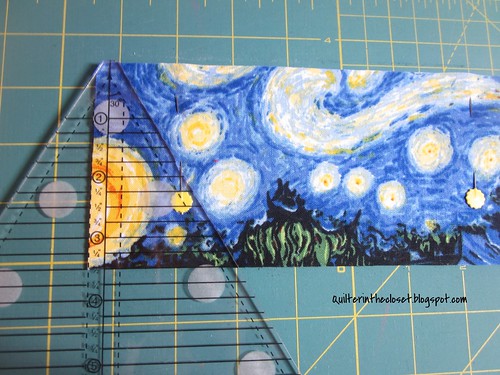 |
| Take your pins out, of course, before making a cut |
In a way, your first cut is going to mimic this cut anyway, so why not pay attention a little and get a 30 degree triangle that will be the right size to fit your blocks. Having something useful is always better than waste, right?
Please make sure you switch sides. If you cut your first strip with the 30 degree triangle positioned like the one above, then make sure your next strip you position the ruler facing the opposite way.
It does make a difference! You will need 30 degree triangles going in both directions to finish off the edges of your quilt. What am I talking about?
2 of the edges of your quilt will be straight lines thanks to the straight line piecing outlined in the pattern. But, the other 2 edges of the quilt will be partial hexagons. My book suggests just cutting off these points, but if you have 30 degree triangles, you can add them to these ends to fill out the edges to a straight line.
How many 30 degree triangles do you need? Hard to say as it depends on how big your quilt will be, right? Plus each cut will give you six IDENTICAL 30 degree triangles. Having them all be the same will likely not fit your needs unless your quilt is essentially the same color throughout.
Diversity of Triangles
We already talked a little in the fabric selection post about repeats. When buying your fabric you want to make sure to get at least 6 of the horizontal repeats.
It is likely that your fabric also has a vertical repeat. See how many suns I have? Each of my strips is going to have about 2 of the same design elements. Given that, I want to make sure that I don't end up with the same exact triangles.
 |
| You might notice is this pic, that I like to use a lot more pins along the cut edges of my stack than the book recommends |
While cutting the triangles down your strip, there are a couple of things you can do to make sure that once you hit this vertical repeat that you aren't cutting identical triangles.
It might be that it works out that one triangle will be facing the opposite way. Hooray, this is easy and you don't have to do anything.
You can also choose to cut a couple of 30 degree triangles somewhere in the middle of your strip. The extra bit of fabric taken from including the seam allowances of the 30 degree triangles will move you just a little further along the repeat so you won't have identical triangles, and you are still getting something useful out of the cuts.
Or you can just slide your ruler along an inch or so and resume cutting triangles. Again, this moves you along the vertical repeat, shifting it enough so that your triangles won't end up the same.
What happens if you end up with a bunch of triangles that are pretty much the same anyway?
You can orient your hexagons differently, meaning that you choose a different corner of your triangle to be the center. This often gives you hexagons that have a completely different look - a different spin if you will.
However, should you choose to do this, you will have to deal with.......
Bias edges
If you piece your half-hexies differently than with the notched end of your triangles in the center. You are effectively moving the bias edges (that you created when cutting the triangles out of the strips) from the interior of your hexagons to the exterior.
What am I talking about and why is this a big deal? I will try to keep it brief....
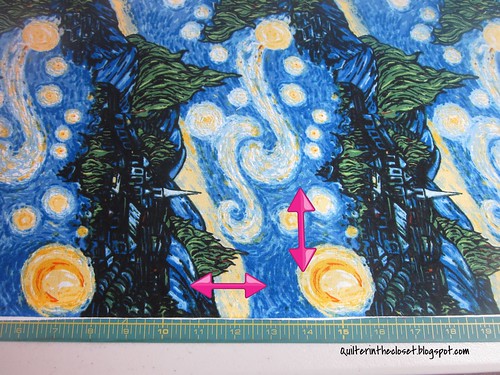 |
| pink arrows indicate the straight grains of the fabric |
Because of the way fabric is woven, it has a "straight-grain" going in perpendicular directions, along the selvage and from selvage to selvage. If you look closely at your fabric, you can actually see the little threads going in these directions. There is a slight difference between the two, but it isn't that important to go into right now. The important part is that these straight-grains are less stretchy, and thus more stable if you cut and piece along them. Whenever you cut diagonally to these straight-grains, you are cutting a bias edge, which is much more stretchy.
By piecing your half-hexies with the notched edges of the triangles in the center, all of your bias edges are contained within the hexagons, leaving the straight-grained sides to stabilize your rows when you piece them together. Said another way, all of your super-stretchy sides will be contained within each row when you start piecing your half-hexies together with other half-hexies, meaning your quilt will be more stretchy in only one direction. If you piece your hexies with a different triangle point in the center, you will have bias edges between your rows as well, making it stretchy in every direction of your quilt.
For you "seasoned" quilters out there, this probably won't be a problem. For you beginners, you might want to minimize the effects of the bias edges by piecing your triangles with the straight-grains on the exterior sides of your hexagons.
Press all your seams OPEN
Again, this is pretty straight-forward. Press every stinking seam open. When everything is pieced together you are going to have 6 seams converging in lots of places in your quilt top. Even if you plan on just quilting in the ditch, these seams are going to be bulky in these places. The best way to distribute some of that bulk is to press your seams open.
Grouping and Layout
Grouping and Layout
Once I piece and pin all my half hexies together, I like to group them in to "mostly" colored groups.
You can see here, I have a mostly dark group, a mostly green group, a mostly blue group, a mostly light colored group, and a group with a bunch of yellow. No doubt, you will have some hexies that are are tough to place, and these will be good transitional hexies.
Now, on your floor or design wall, layout these hexies in their groups. Use those transitional hexies to move from one color to another. There really isn't any right or wrong here.
Once you have a rough draft, try to move some hexies around, maybe even splitting up a set (waste not want not) to even out your edges. Now take a picture!
Preferably without a cat lying on most of your quilt.
Study your picture and decide if there is anything you want to move around. If not, use it as a reference to make sure your rows end up in the order you wanted while piecing them.
You can also add in your 30 degree triangles at this point to smooth out those edges.
PIN
When it comes time to start piecing your rows together, I highly recommend that you pin, A LOT. This is especially important if your hexies have any bias on the exteriors. Perfectly matching up all those points is actually less important than containing some of the stretch. Your quilt will be "busy" enough, so minor imperfections in aligning the seams won't be a big deal, but if one of your bias edges stretches too much, it will be noticeable and may even create a bubble or pleat when it comes to the quilting.
That's about it for this post. If you have any additional tips and tricks for the group, leave a comment below or start a thread in the Flickr group.
Thanks for reading today!
Jen
Tuesday, October 1, 2013
Fabric Tips - One Block Wonder Quilt Along
The post you have all been waiting for - fabric selection tips for the OBW QAL!
The OBW technique creates a hexagon shape with a kaleidoscope effect. Not every fabric will create an interesting grouping of hexagons. Here are some tips to help you select the perfect fabric for your quilt.
There are several things you will need to consider:
If you were to use it, you would have small areas of purple, teal, white, lime green, pink, and a lot of hexagons with a little of each of those colors.
This fabric might be OK. You will have quite a few hexagons that are orange and pink, but plenty that are mostly red.
This paisley print is limited in colors and large scale, but the areas of color are too mingled to be dramatic. Remember those 3.5 inch triangles? They would all be brown and teal. You might have some interesting lines created by the hexagons, but you won't have any dramatic changes in color.
You will have some hexagons that are white or light blue, then some with the darker blue. Transitioning the change in hue across the quilt will be interesting.
This fabric has very limited colors and is high contrast. I think the tricky part will be having enough hexagons that are equally black and white (like where the leaves are) to make the transition from mostly black hexagons to mostly white hexagons.
*** Consider how Scale and Contrast work together **** Remember, 3.5 inch triangles.
It is limited in color, large scale, and the palm fronds would fan out and make nice movement in the blocks. But what about those tree trunks?
I myself am going to experiment a tad with my own QAL quilt. Here's the fabric I have chosen (from Joann's BTW).
It called to me. It has a few more colors than I would suggest. And since the scale and repeat is not as large as I think it should be, I will likely cut smaller triangles than the pattern calls for. I will see what happens. This is supposed to be fun, after all!
The OBW technique creates a hexagon shape with a kaleidoscope effect. Not every fabric will create an interesting grouping of hexagons. Here are some tips to help you select the perfect fabric for your quilt.
There are several things you will need to consider:
- Limited Colors
- Large scale design features
- Contrast
- Potential for Movement
- Length of Repeat
Limited Colors
For best results using the OBW technique, you will want to choose a fabric with 2 or 3 main colors. Additional tiny accent colors are almost irrelevant. By limiting the color scheme, your quilt will have a more harmonious flow and won't be too busy.
One of the reasons I think my Blue and White OBW was so successful is because it was essentially just two colors - blue (in a couple tones and shades) and white. That's it. Here is the original fabric.
Now for some other examples...I walked around my local Joann's and snapped a few camera phone shots of the bolts (so excuse the quality of the pics, please). So you have an idea of scale, I literally just took a picture of the bolts as I held them, so the shots are approximately 8 inches of fabric.
You've got black, white, and red. Your final quilt would be low volume (black and white), with a splashes of red mixed in.
Here is another fabric with limited colors.
Your quilt will have areas of dark blue, light blue and then areas of the cream with blue accents.
Here is another fabric with limited colors.
Your quilt will have areas of dark blue, light blue and then areas of the cream with blue accents.
Large Scale
Now is the time to pull out those large scale prints that you usually don't know what to do with. Think large florals, novelty, even Asian prints that have large motifs. Small scale prints just won't make enough of an impact with this pattern. You are basically going to be cutting 3.5 inch triangles. Ideally, you want the majority of the triangles in your quilt to be mostly one color. Yes, you will want a few hexagons to only be partially one color for transitioning purposes, but if every one of your triangles has 5 colors in it, it will be difficult to group them together.
The fabric above will result in a quilt similar to one of the examples in the book. Most of your blocks will either be light purple, or dark purple. Some will have a little of both, then you will also have some green blocks from the leaves.
The fabric above will result in a quilt similar to one of the examples in the book. Most of your blocks will either be light purple, or dark purple. Some will have a little of both, then you will also have some green blocks from the leaves.
If you were to use it, you would have small areas of purple, teal, white, lime green, pink, and a lot of hexagons with a little of each of those colors.
This fabric might be OK. You will have quite a few hexagons that are orange and pink, but plenty that are mostly red.
This paisley print is limited in colors and large scale, but the areas of color are too mingled to be dramatic. Remember those 3.5 inch triangles? They would all be brown and teal. You might have some interesting lines created by the hexagons, but you won't have any dramatic changes in color.
Contrast
This one is sometimes tricky. High contrasting fabric is interesting, but that doesn't mean that you can't pick a fabric that transitions to another color (think blue to green to yellow). I didn't find any fabrics that really highlighted this possibility, but it is an option.
This fabric has limited colors and they are high contrast. The result will be a quilt with hexagons that are either the dark red, or pink, or bright white and pink. Your quilt can transition from dark red, to bright pink, to light pink. The gray from the leaves would just be an accent color and likely distributed throughout the quilt.
This fabric has a more subtle change in contrast because it is all blue, in varying hues.
This fabric has limited colors and they are high contrast. The result will be a quilt with hexagons that are either the dark red, or pink, or bright white and pink. Your quilt can transition from dark red, to bright pink, to light pink. The gray from the leaves would just be an accent color and likely distributed throughout the quilt.
This fabric has a more subtle change in contrast because it is all blue, in varying hues.
You will have some hexagons that are white or light blue, then some with the darker blue. Transitioning the change in hue across the quilt will be interesting.
This fabric has very limited colors and is high contrast. I think the tricky part will be having enough hexagons that are equally black and white (like where the leaves are) to make the transition from mostly black hexagons to mostly white hexagons.
*** Consider how Scale and Contrast work together **** Remember, 3.5 inch triangles.
Potential for Movement
Having straight lines in your fabric is OK, it will highlight the hexagonal shape of the blocks; however, if not cut exactly straight, they may look like you made a mistake in piecing. Curved lines are easier to piece and will create movement in the blocks.
Straight lines will emphasis the hexagon shape, but anywhere the lines don't line up perfectly, it will look like a mistake in piecing. In the picture above, there are several blocks that had straight lines (from the bamboo stalks of the original fabric). See how the hexagon shape is emphasized. A few of these blocks look lined up just right, but I'm sure if you were able to zoom in on most of them, the lines would not line up.
Whereas curved lines won't be expected to line up perfectly and create the feeling of movement within the block. The paisley fabric above will create swirling kaleidoscopes with lots of movement. This picture is pretty close up, but your quilt would mostly be black with a streak of the cream.
Likewise, this Asian print will have beautiful movement thanks to the wings of the birds.
I would have chosen this fabric for my own quilt for this QAL, but I don't have enough of it! :(
Consider this fabric:
Likewise, this Asian print will have beautiful movement thanks to the wings of the birds.
I would have chosen this fabric for my own quilt for this QAL, but I don't have enough of it! :(
Consider this fabric:
It is limited in color, large scale, and the palm fronds would fan out and make nice movement in the blocks. But what about those tree trunks?
Length of the Repeat
The larger the length of the repeat, the more diversity of blocks you will end up with. This is also important if you are trying to make a quilt of a specific size. To find the repeat, I like to look along the selvage for an easily recognizable design feature, like the stem of a flower, the wing of a particular bird, etc. Using your ruler or measuring tape, measure along the repeat until you find that exact same design feature. This is the length of your repeat. Repeat lengths can vary, but it is unlikely you will find one more than 24 inches. You will need to buy enough fabric to have 6 repeats, plus a little wiggle room (add 6 inches or so). Now if your repeat is only 6 inches, that means you will need 1 yard of fabric plus that wiggle room, so let's just say 1 1/4 yard. The problem is that, 1 1/4 yard of fabric, once cut and pieced is not going to make a very large quilt. So if you were hoping for a throw size, you might want to choose a fabric with a larger repeat.
You could also lengthen the cut you will make for your 6 repeats. For example, if your fabric repeat is 8 inches, you would normally need 48 inches (plus wiggle room) to accommodate the 6 repeats you need for the hexagons. But again, that isn't going to make a large quilt. You could "pretend" your repeat is double the 8 inches = 16 inches and get 6 repeats or 96 inches (plus wiggle room). This will yield a much larger quilt, but you will have to work a little to make sure you cut the triangles for the hexagons differently so you don't end up with 2 of the exact same hexagons in your quilt. This will make more sense when we get to the cutting tips portion of the quilt along.
Additional fabric options
Additional fabric options
When you buy your fabric, you might want to consider if you will be adding a border of the original fabric (which looks nice and gives everyone a hint of where your beautiful design came from) or if you will be using it on the backing. If you said yes to either of these ideas, then you will want to buy more than the "required" amounts, yes? Now if you are not in love with your fabric but only choose it because you liked the colors and it fit the other requirements, then look for a coordinating fabric to fit these needs.
Renegades
Here's the thing, you don't have to follow all or any of the tips above. It is your quilt. You might have a fabric that is calling to you and skips a few of the suggestions above. Does that mean that your quilt will not be interesting? NO, it does not! There were several quilts in the gallery section of my OBW book that didn't seem to follow the rules above, and they turned out lovely.
Renegades
Here's the thing, you don't have to follow all or any of the tips above. It is your quilt. You might have a fabric that is calling to you and skips a few of the suggestions above. Does that mean that your quilt will not be interesting? NO, it does not! There were several quilts in the gallery section of my OBW book that didn't seem to follow the rules above, and they turned out lovely.
I myself am going to experiment a tad with my own QAL quilt. Here's the fabric I have chosen (from Joann's BTW).
It called to me. It has a few more colors than I would suggest. And since the scale and repeat is not as large as I think it should be, I will likely cut smaller triangles than the pattern calls for. I will see what happens. This is supposed to be fun, after all!
I hope these tips helped. Now go hit the sale racks at your favorite fabric stores, there are usually some excellent finds there.
Any questions?
Thanks for reading,
Jen
Thursday, September 26, 2013
Kick off! - One Block Wonder Quilt Along
Welcome to the kick off of the One Block Wonder Quilt Along! I hope you have had a chance to gather your supplies and start thinking about what kind of quilt you might like to create.
Before we get to the mini-interview, I would like to mention a few things.
A mini-interview with Maxine Rosenthal, co-author of the One Block Wonders books.
When and how did you start quilting?
I started quilting when Penny McMorris was on Public TV. She was sewing on a featherweight machine and it didn't look too hard. That was in the mid 80's. Besides I wanted a quilt. I also joined a local quilt guild, which gave me much inspiration and instruction.
How did you meet Ms. Pelzmann?
I met Joy in a quilting class at Minnesota Quilters, our state guild. She asked if I made my quilts using a computer. She was shocked to find that I just did it on the fly, designing on a wall, then sewing it together.
How did the two of you come up with the idea of the One Block Wonders technique?
I came up with the idea of the One Block Wonder technique because though I loved kaleidoscopes, they always looked like a bulls-eye on a background and I wanted to eliminate the background. When I began doing these, I called them Kaleidoscopic Watercolor.
Before we get to the mini-interview, I would like to mention a few things.
- First, there is still plenty of time to join in. Just join the Flickr group and gather the supplies.
- Time - a couple people have looked at the schedule and worried that there wouldn't be enough time to complete a top by the end of October. Let me reassure you, there is!
- We are using one fabric
- cutting 6 pieces with each slice of the rotary cutter makes for extremely efficient cutting time
- all straight line piecing (no Y seams)
- the longest part of the process is deciding how to group and arrange your hexagons
- You only have to finish a top and there is no size requirement to link up to the QAL
- This QAL is very beginner friendly because of all the reasons listed above!
A mini-interview with Maxine Rosenthal, co-author of the One Block Wonders books.
When and how did you start quilting?
I started quilting when Penny McMorris was on Public TV. She was sewing on a featherweight machine and it didn't look too hard. That was in the mid 80's. Besides I wanted a quilt. I also joined a local quilt guild, which gave me much inspiration and instruction.
How did you meet Ms. Pelzmann?
I met Joy in a quilting class at Minnesota Quilters, our state guild. She asked if I made my quilts using a computer. She was shocked to find that I just did it on the fly, designing on a wall, then sewing it together.
How did the two of you come up with the idea of the One Block Wonders technique?
I came up with the idea of the One Block Wonder technique because though I loved kaleidoscopes, they always looked like a bulls-eye on a background and I wanted to eliminate the background. When I began doing these, I called them Kaleidoscopic Watercolor.
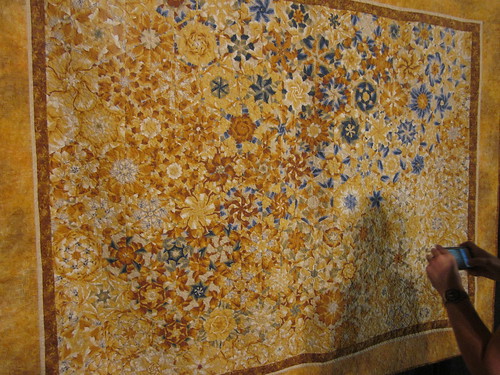 |
| "I know where the summer goes" by Cathie Ugrin at the 2012 International Quilt Festival in Long Beach |
Just about every major quilt show I attend has an example of your OBW technique. Do you have a favorite one that you have seen in exhibition and what was the original fabric like?
I love all the quilts that I see at exhibits. It makes my heart sing to know that people are using this technique and producing such fantastic ART!!! These quilts follow my mantra - they should look hard and yet be easy.
What is the biggest tip you can give with regard to the stacking and cutting process?
The biggest tip I can give anyone is to have fun. These quilts have so much going on that it hides inaccuracies well. Precision is elusive, I do though, aim for accuracy, but it is only an aim.
When I made my quilt, I found the seams a little bulky where the triangles met to form hexagons, do you have any tips for getting them to lie a little flatter?
Be sure to press all your seams open, even when sewing the long columns together. That will distribute the bulk the best.
I ended up just doing a simple stipple for my quilting design, do you have any other quilting recommendations?
All your work has gone into the quilt top and its design. You do not want the quilting to outshine this gorgeous design. You are so right, the simplest quilting is the best.
To you travel and teach your technique?
I have traveled all around the states giving lectures and classes. I always tell my daughter that people actually pay to hear me talk. A little fact that our children need to know.
Your One Block Wonders book was published a while ago, what have you been working on since, and do you have anything new to share with my readers?
My favorite is Escher. I tried to incorporate his ideas of impossible structures in the third book. Now that I am a grandmother, I am making more baby quilts. I consider these the very best 'I Spy' quilts, where I use the original fabric as the border so that he can find where each kaleidoscope comes from. I am still fascinated to see what each different piece of fabric will produce.
How does it make you feel that your OBW technique is still getting attention?
I am thrilled to find that the OBW technique is still being used and in quilt shows around the country. C&T has put out a new calendar with one of my quilts on the cover!!!!
Thank you for asking me to be a part of your blog/quilt along.
And thank you, Maxine, for joining us today for our kick off post!
I just love Maxine's mantra of creating quilts that look hard and yet are easy. I also like her idea using this technique with a novelty fabric to create I Spy quilts for her grandchildren.
There is also another Flickr Group devoted to OBW quilts, in case you need some additional inspiration. I will see you back here next Thursday for a ridiculously long post about fabric selection tips.
If you have any questions about the quilt along, or even some you would like me to pass along to Maxine, please leave them in the comments below.
Thanks for reading,
Jen
I love all the quilts that I see at exhibits. It makes my heart sing to know that people are using this technique and producing such fantastic ART!!! These quilts follow my mantra - they should look hard and yet be easy.
What is the biggest tip you can give with regard to the stacking and cutting process?
The biggest tip I can give anyone is to have fun. These quilts have so much going on that it hides inaccuracies well. Precision is elusive, I do though, aim for accuracy, but it is only an aim.
When I made my quilt, I found the seams a little bulky where the triangles met to form hexagons, do you have any tips for getting them to lie a little flatter?
Be sure to press all your seams open, even when sewing the long columns together. That will distribute the bulk the best.
I ended up just doing a simple stipple for my quilting design, do you have any other quilting recommendations?
All your work has gone into the quilt top and its design. You do not want the quilting to outshine this gorgeous design. You are so right, the simplest quilting is the best.
To you travel and teach your technique?
I have traveled all around the states giving lectures and classes. I always tell my daughter that people actually pay to hear me talk. A little fact that our children need to know.
Your One Block Wonders book was published a while ago, what have you been working on since, and do you have anything new to share with my readers?
My favorite is Escher. I tried to incorporate his ideas of impossible structures in the third book. Now that I am a grandmother, I am making more baby quilts. I consider these the very best 'I Spy' quilts, where I use the original fabric as the border so that he can find where each kaleidoscope comes from. I am still fascinated to see what each different piece of fabric will produce.
How does it make you feel that your OBW technique is still getting attention?
I am thrilled to find that the OBW technique is still being used and in quilt shows around the country. C&T has put out a new calendar with one of my quilts on the cover!!!!
Thank you for asking me to be a part of your blog/quilt along.
And thank you, Maxine, for joining us today for our kick off post!
I just love Maxine's mantra of creating quilts that look hard and yet are easy. I also like her idea using this technique with a novelty fabric to create I Spy quilts for her grandchildren.
There is also another Flickr Group devoted to OBW quilts, in case you need some additional inspiration. I will see you back here next Thursday for a ridiculously long post about fabric selection tips.
If you have any questions about the quilt along, or even some you would like me to pass along to Maxine, please leave them in the comments below.
Thanks for reading,
Jen
Subscribe to:
Posts (Atom)

